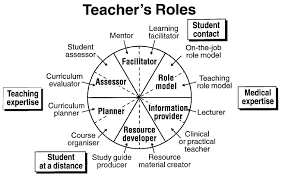As an educator I frequently suffer from identity crisis. So many roles, often overlapping. One moment I am a surrogate mother wiping away tears, next I am a nurse applying a band-aid, later I am a referee resolving a dispute or enforcing rules. Too often I feel like an elastic stretched way too far. When all goes well I get to be a motivator or muse and that is why I do it.
According to the NMC Horizon Report the role of the teacher is changing to one of curating and
facilitating learning experiences and encouraging student exploration to discover passions. This is a significant shift from the sage on the stage. As Lamier points out, students aren’t consumers of facts. They are active creators of knowledge. This is but one of many contributing factors to the changing role of educators.
Along with traditional roles teachers are expected to incorporate technology into one’s pedagogical strategies to meet the needs of 21st century learners. The NMC Horizon Report (2016) also states that one in three educators surveys feels their schools do not provide adequate support to help them integrate technology n the classroom. School District #68 has offered some opportunities for educators to develop proficiency with technology such as offering teachers some basic training with Google and Chromebooks with the expectation that they share their expertise. It is a start but only that. It represents only a few small steps in a long journey. For the most part teachers are left to seek professional development opportunities on their own. Compare this to Australia where Queensland’s Department of Education and Training will sponsor “Developing Our Teachers,” an opportunity for educators to increase their digital competencies and discover best practices for teaching STEM subjects. (NMC Horizon Report, 2016)
Incorporating technology into one’s instructional design is not the only way that the role of the teacher has changed in recent years. Harrison and Killion (2017) cite ten roles adopted by present day educators. Among these are resource provider, instructional specialist, curriculum specialist, classroom supporter, mentor, school leader, learning facilitator, data coach, catalyst for change, and learner. I assume at least 7 of these roles on a daily basis. My tendency to go to bed early is beginning to make sense. Who wouldn’t be exhausted trying to be all those things?
The changing role may require educators and administrators to rethink how education is delivered in their school or classroom in order to make the changing role of the teacher more manageable. The alternative may be premature teacher burnout.
References
(2017). NMC Horizon Report: 2016 k-12 Edition. . Retrieved 5 February 2017, from https://drive.google.com/file/d/0B6btfF7n9V
(2017). Bctf.ca. Retrieved 5 February 2017, from http://bctf.ca/uploadedFiles/Public/Issues/I
Harrison, Cindy and Joellen Killion. Teachers as Leaders:Ten Roles for Teacher Leaders . Educational Leadership. (2017). September 2007, Volume 65, Number 1. Retrieved 5 February 2017, from http://www.ascd.org/publications/educational-leadership/sept07/vol65/num01/Ten-Roles-for-Teacher-Leaders.aspx
Lanier, J. (1997). Redefining the Role of the Teacher: It’s a Multifaceted Profession. Edutopia. Retrieved 5 February 2017, from https://www.edutopia.org/redefining-role-teacher
Image source: http://www.ctetadda.com/2016/10/role-of-teacher-in-classroom-instruction.html

